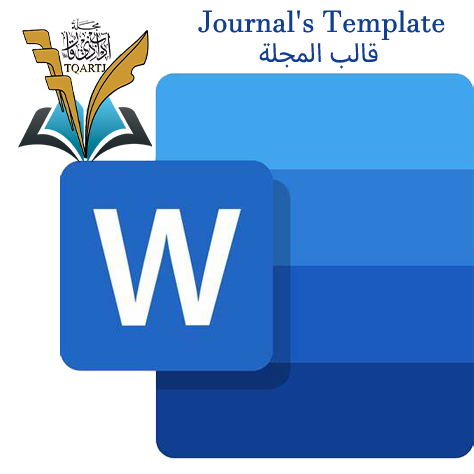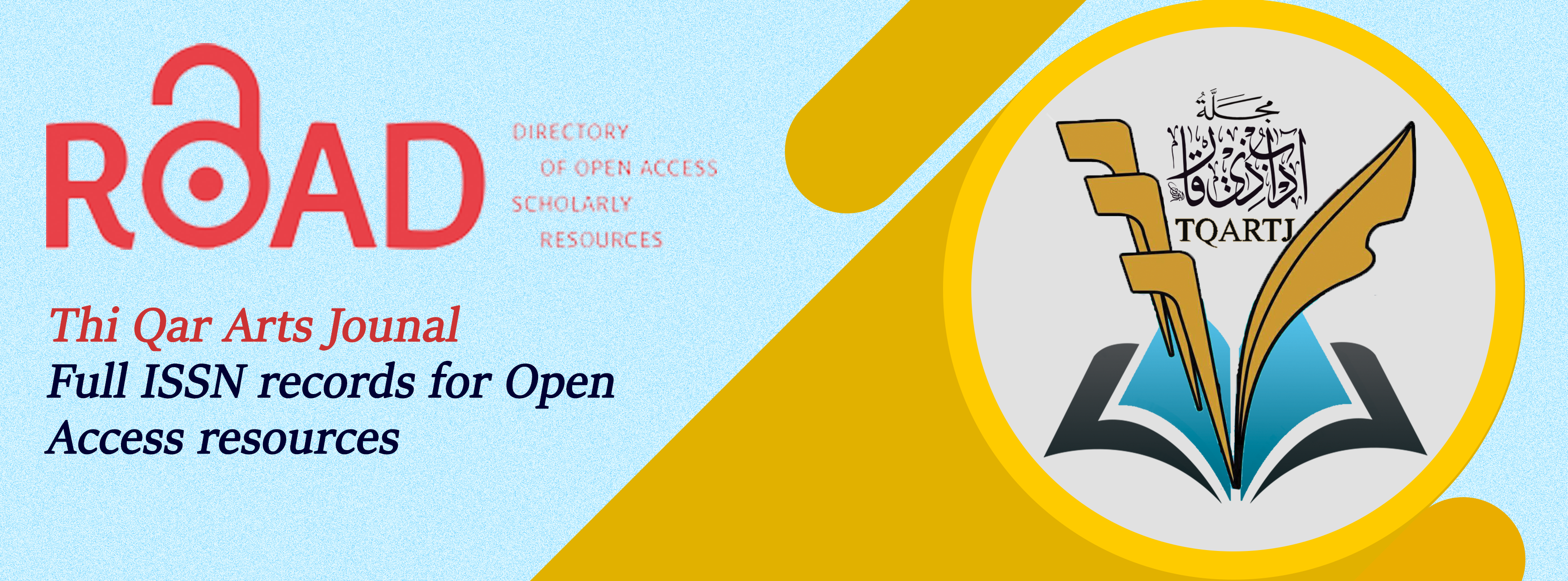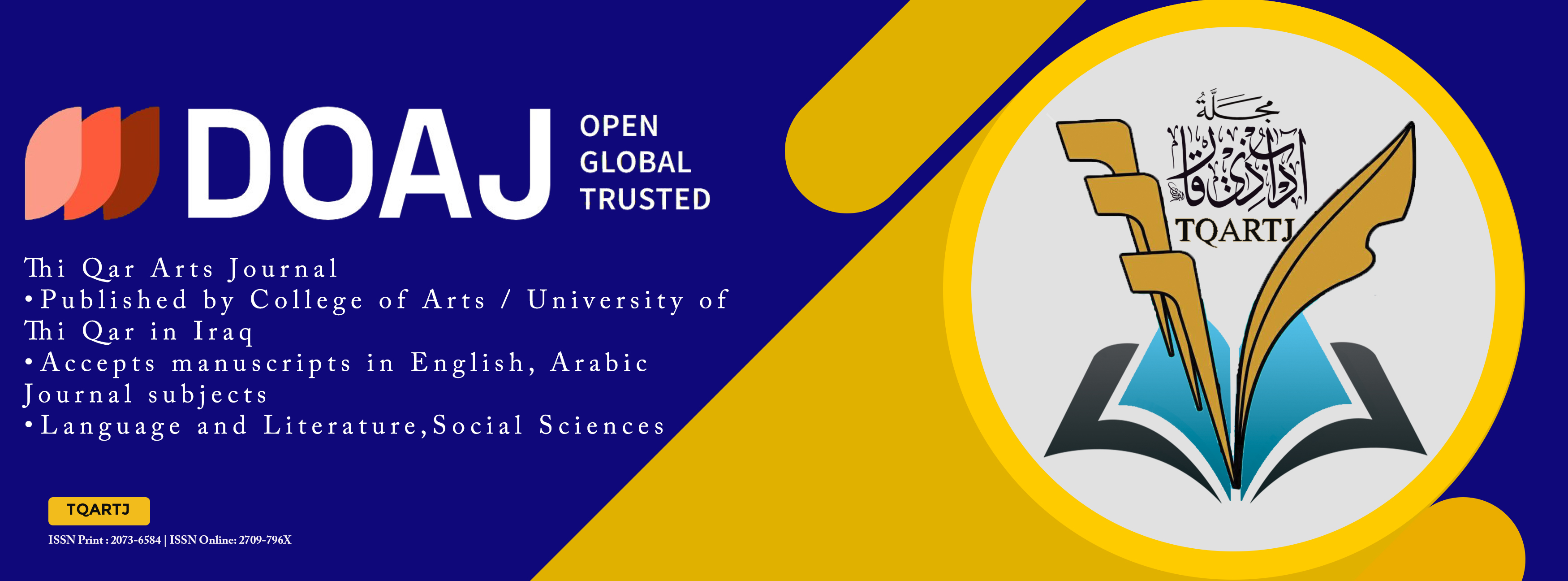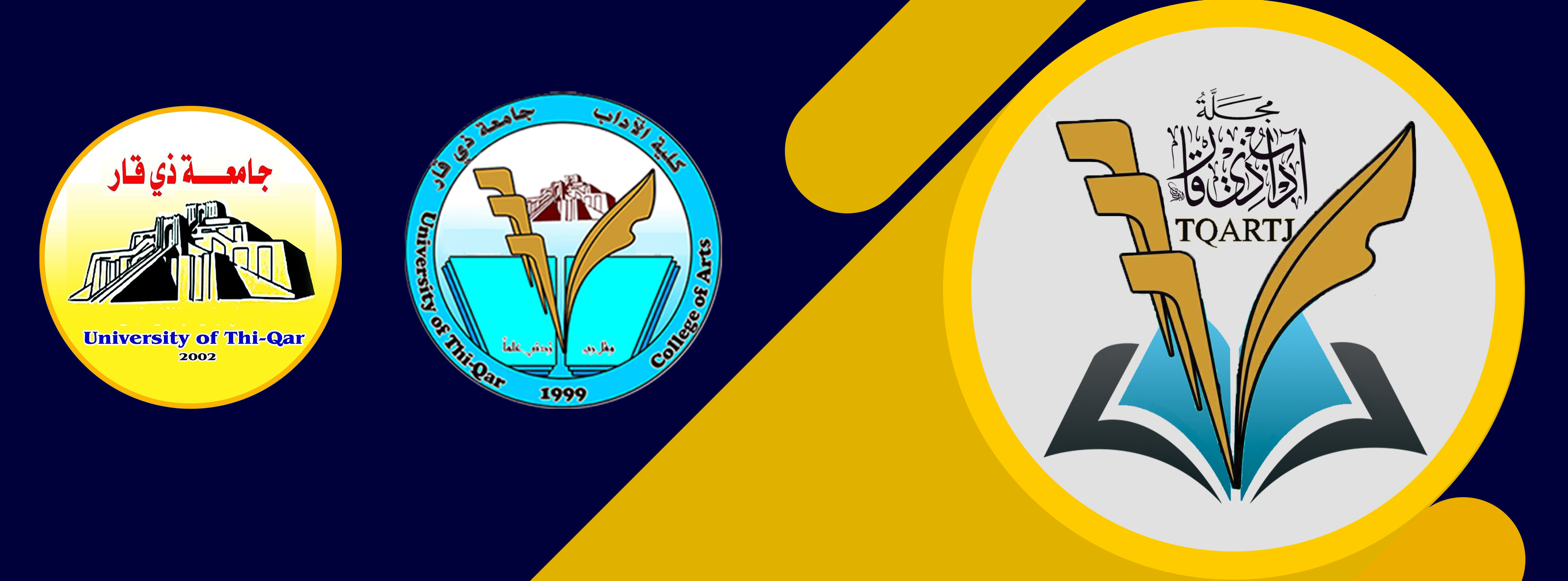The aesthetics of the metaphorical image of Imam Hussein (peace be upon him) in Andalusian literature (Almuahadins era as an example)
DOI:
https://doi.org/10.32792/tqartj.v1i45.533Keywords:
Imam Hussein , metaphorical images , Andalusian literature , Almuahadins eraAbstract
The poetic image is considered an essential pillar of the literary work, and a very important structural element for studying the essence of the poetic text. It is the most prominent tool that enables the critic to explore the poet’s experience and psychological formation, and a standard for measuring his talent and judging him. It has received the attention of critics and scholars, and received a wide range of controversy. And research, with its flexible nature, interconnected connections, and the multiplicity and diversity of its descriptive structures.
Metaphor is one of the most prominent mechanisms for creating the poetic image, and the formal means that almost all critics agree upon, including the ancient Arab critics, who celebrated the poetic image and linked it to rhetorical colors.
Our research, titled (The aesthetics of the metaphorical image of Imam Hussein, peace be upon him, in Andalusian literature - the Almohad era as a model), attempts, based on the descriptive-analytical approach, to clarify the features of the metaphorical image embodied by the poets of the Almohad era of Imam Hussein (peace be upon him) in their poetry, such as Ibn al-Abar al-Qadha’i. And Abu Al-Bahr Safwan Al-Mursi Al-Tajibi, Hazem Al-Qartajani, Ahmad bin Shakil Al-Andalusi, Nahed bin Muhammad Al-Andalusi, Abu Al-Abbas Al-Jarawi, and Abu Al-Baqa Al-Randi, and the places where we see the poets of the Almohad era relying on metaphor in embodying the image of Imam Hussein (peace be upon him), as a literary artefact that represents The image plays its role. The results indicated that Andalusian literature was not purely Umayyad, but rather a part of it was committed Shiite literature, and the throats of the poets of the Almohad era began to chant with praise and lamentation for the family of the Prophet and Imam Hussein, and the Husseini issue became one of the most powerful and present phenomena of Shiism in Andalusia, and it was noted that most poets relied on images. The metaphors in their poems, and most of the images were similar in terms of meaning and concept, aimed at crying, drawing tears, and commemorating Ashura.
Downloads
References
The Holy Quran.
Firstly – Printed Books:
Ibn Al-Athir, Abu Al-Hassan Ali bin Muhammad (1978), “The Complete History,” Beirut: Dar Al-Kutub Al-Ilmiyah.
Ibn Al-Athir, Abu Al-Hassan Ali bin Muhammad (1983), “The Widespread Example in the Literature of the Writer and the Poet,” edited by: Ahmad Al-Hawfi and Badawi Tabana, 2nd edition, Riyadh: Dar Al-Rifa’i.
Ismail, Ezzedine (1988), “Contemporary Arab Poetry: Its Issues and Artistic and Spiritual Phenomena,” Beirut: Dar Al-Awda.
Ibn Abi Usaibia, Muwaffaq Al-Din Abu Al-Abbas (no date), “The Sources of News in the Classes of Physicians,” edited by: Nizar Rida, Beirut: Dar Maktabat Al-Hayat.
Al-Amin, Hassan (1983), “Introduction to Durar Al-Samt in the News of the Sibt,” Shia Islamic Encyclopedia, Beirut: Dar Al-Ta’aruf.
Al-Jahiz, Abu Uthman Amr bin Bahr bin Mahjub (1967), “The Expression and Elucidation,” edited by: Abd Al-Salam Muhammad Haroun, 3rd edition, Cairo: Maktabat Al-Khanji.
Al-Jahiz, Abu Uthman Amr bin Bahr bin Mahjub (1996), “The Animal,” edited by: Abd Al-Salam Haroun, Beirut: Dar Al-Jeel.
Al-Jarawi, Ahmad bin Abd Al-Salam, (1994), “Diwan of Abu Al-Abbas,” crafted by: Ali Ibrahim Al-Kurdi, Damascus: Dar Saad Al-Din.
Al-Jurjani, Abdul Qahir (1991), “Secrets of Eloquence,” edited by: Mahmoud Muhammad Shaker, Cairo: Dar Al-Madani, Jeddah.
Al-Jurjani, Abdul Qahir (1992), “Signs of Miracles,” edited by: Mahmoud Muhammad Shaker, 3rd edition, Cairo: Dar Al-Madani, Jeddah.
Al-Jurjani, Ali bin Abdul Aziz (2006), “The Mediation between Al-Mutanabbi and His Opponents,” edited and explained by: Muhammad Abu Al-Fadl Ibrahim and Ali Al-Bijawi, Beirut – Sidon: Al-Maktaba Al-Asriya.
Al-Jurjani, Ali bin Muhammad (no date), “The Collection of Definitions,” edited by: Muhammad Siddeq Al-Minshawi, Cairo: Dar Al-Fadila.
Abu Haqqa, Ahmad (1979), “Commitment in Arab Poetry,” Beirut, Dar Al-Ilm Lilmalayin.
Al-Khatib Al-Qazwini, Jalal Al-Din Abu Al-Ma’ali Muhammad bin Abdul Rahman (1989), “The Clarification in the Sciences of Rhetoric,” edited by: Muhammad Abdul Mon’em Khafaji, 3rd edition, Beirut: Dar Al-Jeel.
Ibn Al-Khatib, Lisan Al-Din (2002), “The Coverage in the News of Granada,” edited by: Yusuf Ali Al-Tawil, Lebanon: Dar Al-Kutub Al-Ilmiyah.
Ibn Al-Khatib, Lisan Al-Din (1956), “The Works of the Famous in Those Who Were Pledged Allegiance Before Puberty Among the Kings of Islam,” edited by: Levi (Provençal), Beirut: Dar Al-Shorouk.
Abu Deeb, Kamal (1995), “The Dialectic of Concealment and Revelation,” 4th edition, Beirut: Dar Al-Ilm Lilmalayin.
Al-Ruba’i, Abdul Qahir (1980), “The Artistic Image in the Poetry of Abu Tammam,” Jordan – Irbid: Yarmouk University Publications.
Ibn Abi Zar’, Ali bin Abdullah Al-Fasi (1972), “The Entertaining Companion in the Garden of Qurtas in the News of the Kings of Morocco and the History of the City of Fez,” Rabat: Dar Al-Mansour for Printing and Paper.
Salem, Sayed Abdel Aziz (no date), “The History of Muslims and Their Monuments in Andalusia,” Lebanon: Dar Al-Ma’arif.
Al-Salmi, Abdul Malik bin Habib (2008), “The Book of History,” cared for by: Abdul Ghani Musto, Beirut: Sons of Al-Sharif Al-Ansari Company.
Shawqi, Ahmed (2000), “Diwan of Shawqiyat,” edited by: Ali Abdul Mon’em, Egypt: Dar Al-Qahira.
Al-Abadi, Ahmed Mukhtar (no date), “In the History of Morocco and Andalusia,” Beirut: Dar Al-Nahda Al-Arabiya.
Abbas, Fadl Hassan (2005), “Rhetoric: Its Arts and Varieties,” Jordan: Dar Al-Furqan.
Atiq, Abdul Aziz (1985), “In Arabic Rhetoric: The Science of Expression,” Beirut: Dar Al-Nahda Al-Arabiya.
Ibn Idhari, Abu Al-Abbas Ahmad bin Muhammad (1983), “The Western Statement in the News of Andalusia and the Maghreb,” edited and reviewed by: J.S. Collan and Levi Provençal, 3rd edition, Beirut: Dar Al-Thaqafa.
Al-Adhari, Ahmad bin Omar (1965), “The Embellishment of News and the Variation of Monuments,” by Abdul Aziz Al-Ahwani, Madrid.
Al-Askari, Abu Hilal (1952), “The Book of the Two Crafts: Writing and Poetry,” edited by: Ali Muhammad Al-Bijawi, Muhammad Abu Al-Fadl Ibrahim, Beirut: Dar Ihya Al-Kutub Al-Arabiya.
Asfour, Jaber (1992), “The Artistic Image in the Arab Critical and Rhetorical Heritage,” 3rd edition, Beirut: The Arab Cultural Center.
Qara, Hayat (1998), “Abu Al-Abbas Ahmad bin Shakil Al-Andalusi, the Poet of Sharrish,” Abu Dhabi: The Cultural Complex.
Ibn Qutaybah, Abu Ja’far Abdullah bin Muslim (1990), “The Imamate and Politics,” edited by: Ali Shiri, Beirut: Dar Al-Adwa.
Al-Qurtajani, Hazem (1973), “Poems and Fragments Crafted by Abu Al-Hassan Hazem Al-Qurtajani,” edited by: Al-Khoja Muhammad Al-Habib, Tunisia: Tunisian House for Publishing.
Al-Muraghi, Ahmed Mustafa (no date), “Sciences of Rhetoric (Expression, Meanings, and Beauty),” Beirut: Dar Al-Kutub Al-Ilmiyah.
Maslouh, Saad (2002), “In the Literary Text: Statistical Stylistic Studies,” 3rd edition, Cairo: World of Books.
Al-Maqqari, Ahmad bin Muhammad Al-Tilimsani (1949), “Nafh Al-Tayyib from the Moist Branch of Andalus,” edited by: Muhammad Muhyi Al-Din Abdul Hamid, Egypt: Sa’adah Press.
Maki, Mahmoud Ali (1993), “Shiism in the Maghreb Countries Until the Middle of the Fifth Hijri Century,” Cairo: Dar Al-Nahda Al-Arabiya.
Maki, Mahmoud Ali (2004), “Shiism in Andalusia from the Conquest Until the End of the Umayyad State,” Cairo: Maktabat Al-Thaqafa Al-Diniya.
Ibn Manzur, Abi Al-Fadl Jamal Al-Din Muhammad bin Makram (no date), “Lisan Al-Arab,” Beirut: Dar Sader.
Al-Nuwayri, Shihab Al-Din Ahmad bin Abdul Wahhab (no date), “The Ultimate Ambition in the Arts of Literature,” edited by: Abdul Majid Turhini, Beirut: Dar Al-Kutub Al-Ilmiyah.
Secondly - University Dissertations and Theses:
Balghaith, Abdulrazzaq (2010), “The Poetic Image in the Poetry of the Poet Ezzedine Mahyoubi: A Stylistic Study,” Master’s Thesis, Faculty of Arts, Algeria: University of Bouzareah.
Al-Shiddi, Asma bint Abdulrahman bin Muhammad (2014), “Time in Andalusian Poetry in the Era of the Taifa Kingdoms (422 - 484 AH),” Master’s Thesis, Faculty of Arabic Language, Saudi Arabia: Imam Muhammad bin Saud Islamic University.
Mahwi, Rabeh (2009), “The Poetic Image in the Diwan of Prince Abi Rabia Sulaiman bin Abdullah Al-Muwahhid,” Master’s Thesis, Faculty of Arts, Algeria: University of Mohamed Khider.
Thirdly – Research in Journals and Periodicals:
Al-Zubaidi, Nadhir Haroun (2019), “A Cultural Reading of the Husseini Mourning,” Cultural Symposium, The Cultural House in Al-Aziziya District affiliated with the General Directorate of Cultural Relations in the Iraqi Ministry of Culture, Tourism, and Antiquities. 44. Said, Aqeel Muhammad (2017), “Imam Hussein, peace be upon him, in Andalusian Culture: Ibn Al-Abbar Al-Quda’i as an Example,” Journal of the Islamic University College, Issue 43.
Abbas, Reda Hadi (no date), “The Revolution of Imam Hussein, peace be upon him, in Andalusian Heritage,” Journal of Ahl Al-Bayt, Issue 7.
Al-Ghazali, Abdul Amir Anad (2004), “Hussein, peace be upon him, in Andalusian Poetry,” Najaf Studies Journal, Third Issue.
Al-Haras, Abdul Salam (1979), “The Tragedy of Hussein in Andalusian Literature,” Al-Manahil Magazine, Rabat, Issue 14.
Downloads
Published
Issue
Section
Categories
License
Copyright (c) 2024 Moshreq Shaban Madhul, Dr. Somayeh Hassanalian

This work is licensed under a Creative Commons Attribution 4.0 International License.
The journal applies the license of CC BY (a Creative Commons Attribution International license). This license allows authors to keep ownership of the copyright of their papers. But this license permits any user to download, print out, extract, reuse, archive, and distribute the article, so long as appropriate credit is given to the authors and the source of the work. The license ensures that the article will be available as widely as possible and that the article can be included in any scientific archive.



















